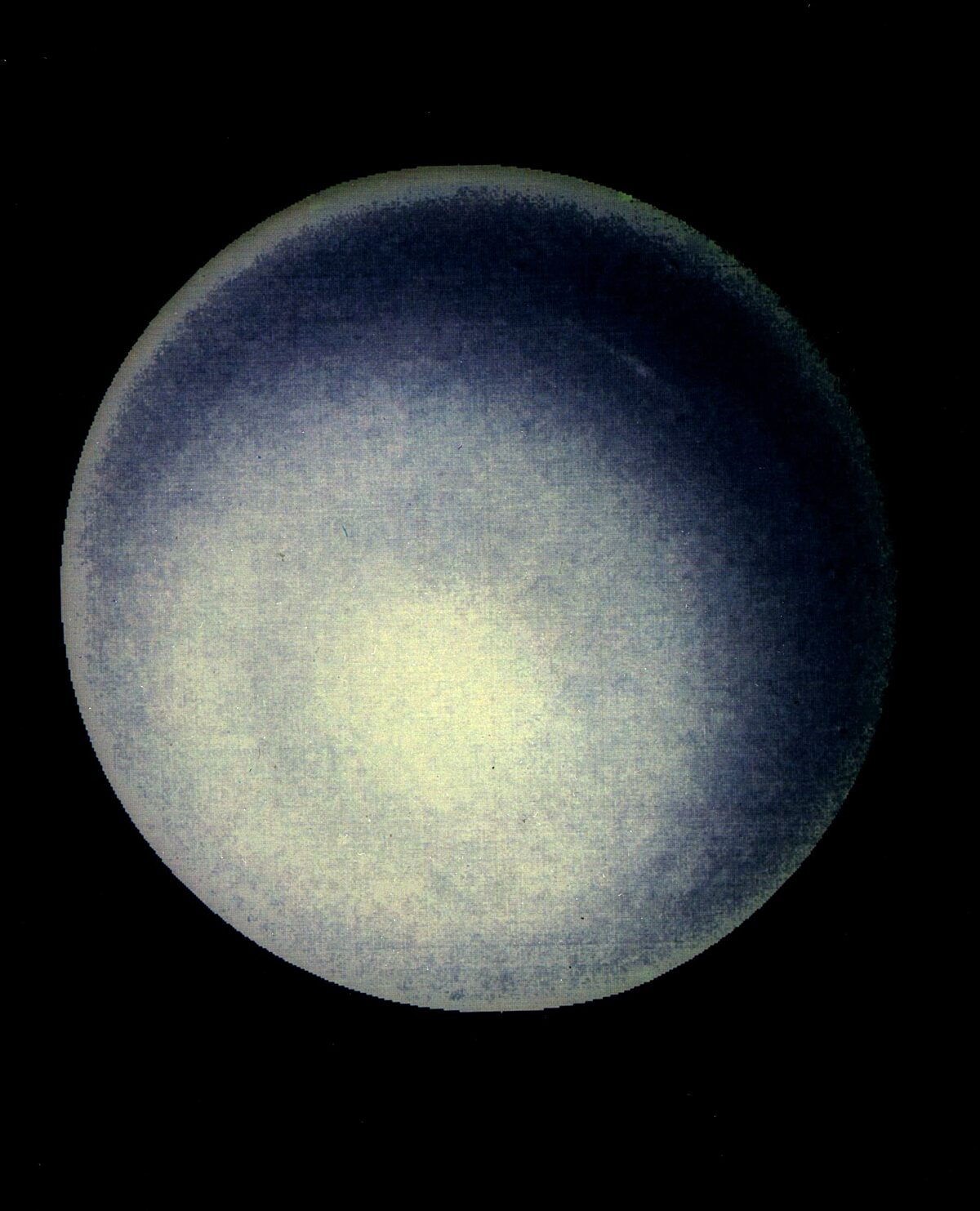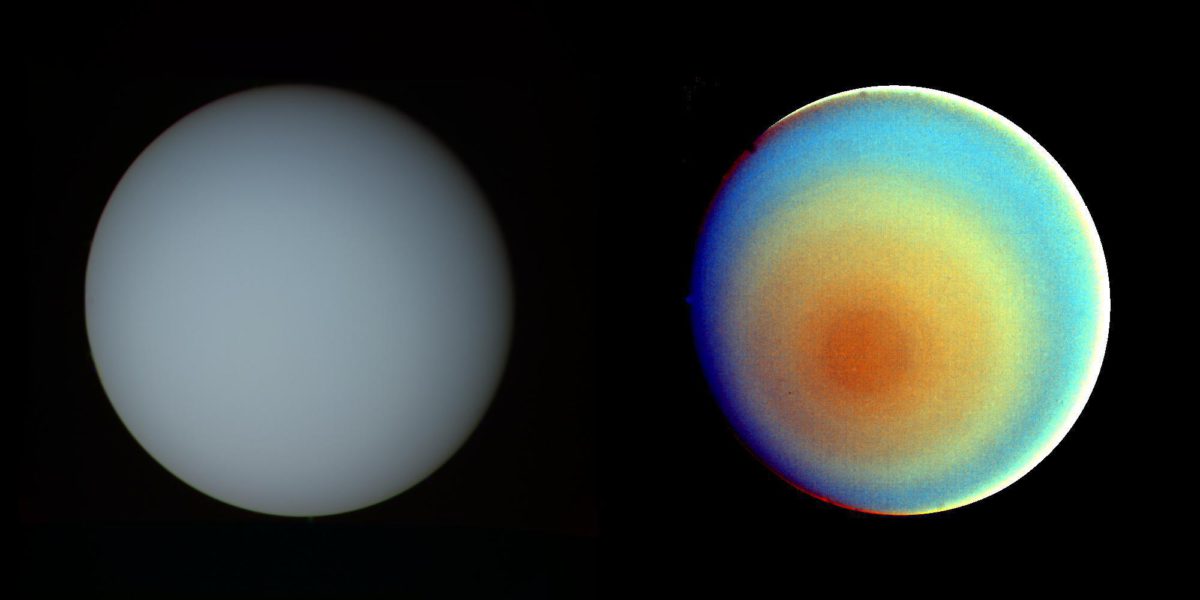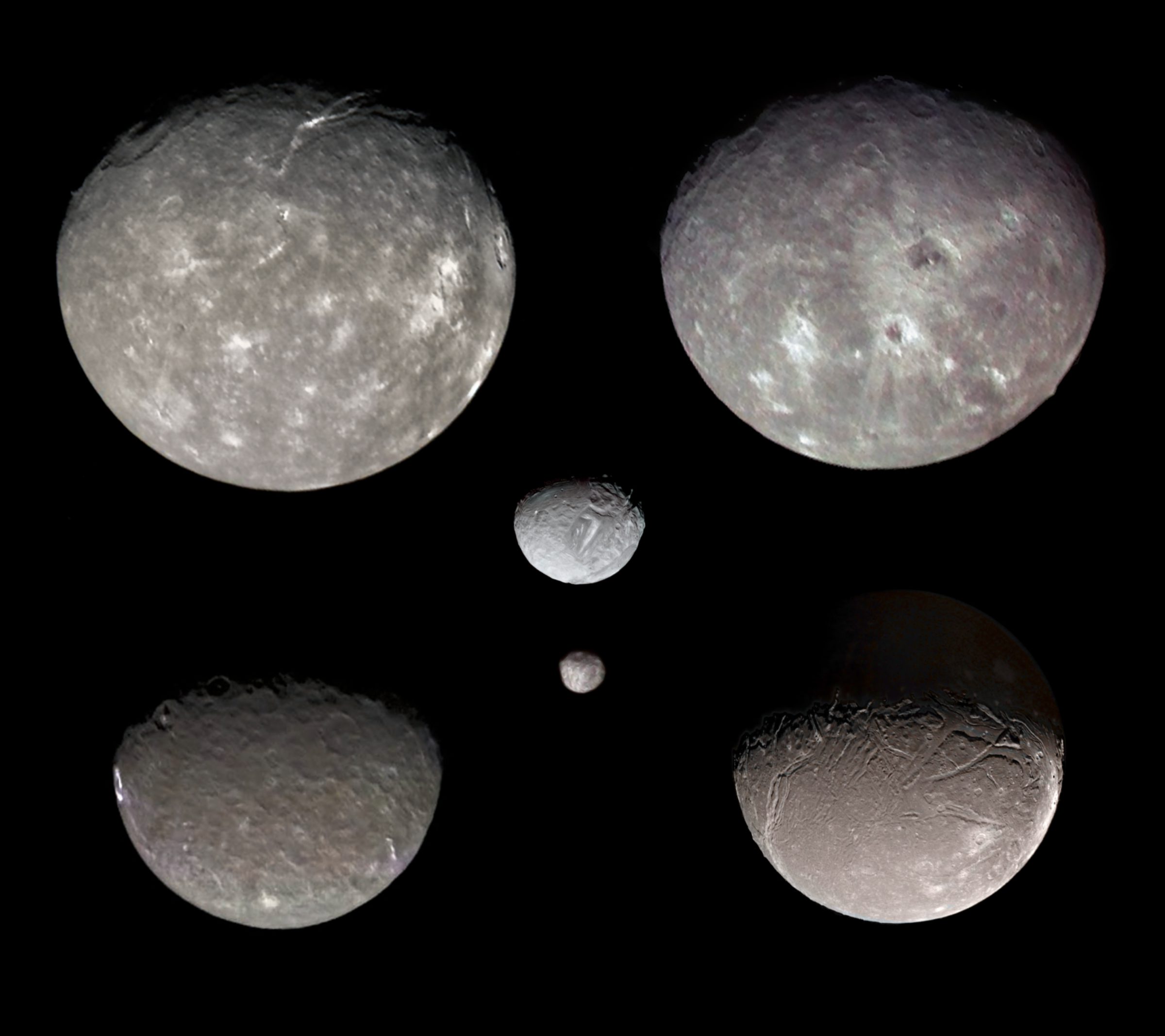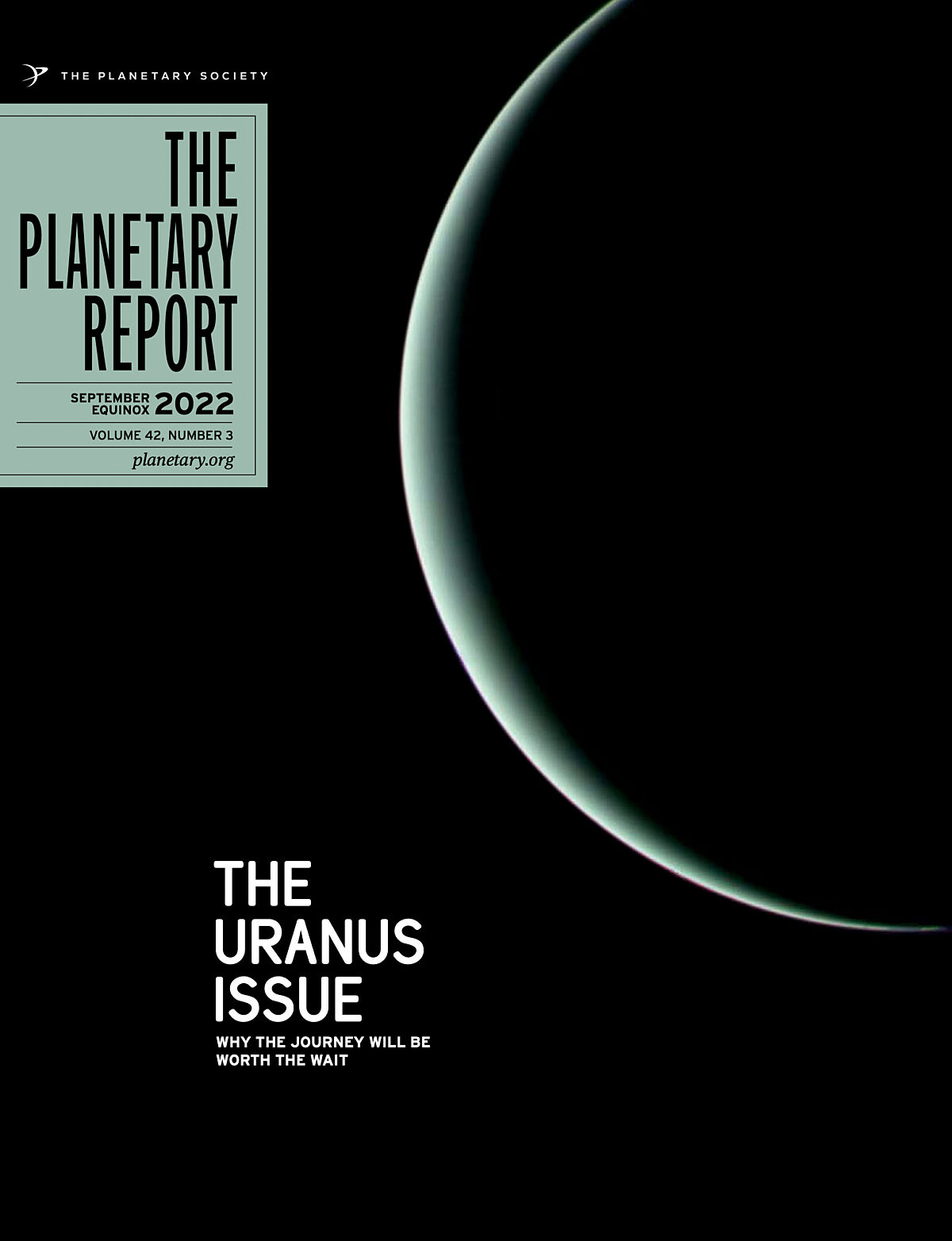Patience for Uranus
We’ve only visited Uranus once. NASA’s Voyager 2 spacecraft made humanity’s lone visit on Jan. 24, 1986. During a six-hour period, the spacecraft captured our only up-close images of Uranus, its rings, and its large moons.
In the following 3 1/2 decades, scientists have scrutinized every scrap of data returned by Voyager’s science instruments. They’ve also learned new things about our seventh planet using ground-based telescopes, the Hubble Space Telescope, and soon the James Webb Space Telescope (JWST). But they can only figure out so much without going back for a second up-close look.
“We’ve been saying for a couple of decades that getting back to the ice giants is really important scientifically,” said Heidi Hammel, vice president of science for the Association of Universities for Research in Astronomy and vice president of the board of directors of The Planetary Society.
She and her colleagues may soon get their wish. A new report by the National Academy of Sciences says a Uranus orbiter and probe should be the top priority for NASA’s next large-scale mission, known as a flagship. The mission could launch as soon as 2031 and would provide a comprehensive look at the entire Uranus system, from the planet’s atmosphere to its exotic mantle to its diverse rings and moons.

It’s an exciting prospect. But Uranus demands patience for those who study it. First, NASA must ensure two existing flagship missions, the Europa Clipper and the Mars Sample Return program, are solidly on their way to the launch pad. Depending on the positions of the planets and the available rockets at launch time, it would take a minimum of 11 years for a spacecraft to travel to Uranus. Throw in some delays typical of large-scale space projects, and you’re looking at an arrival time of more than 20 years from now in the mid- to late 2040s.
Scientists supporting the mission know what they’re getting into.
“I tell folks, ‘This isn’t going to be my mission,’” said Amy Simon, a senior scientist for planetary atmospheres research at NASA’s Goddard Space Flight Center. “Just the time scales involved — I’ll be the wizened elder at that point, which is fine. It’s a mission for the next generation.”
Richard Cartwright, a research scientist at the SETI Institute who studies icy moons, is part of that generation. But he knows much of his career will be behind him before he sees new images of Uranus’ moons.
“I will be a late-career scientist at that point, as will all the other current early career scientists and engineers who are working to make this mission happen,” he said.
It will be an even newer generation, then, that gets to enjoy the spoils from a Uranus mission.
“I think the future generation of planetary scientists who are currently in elementary through high school or are undergraduates are the ones who will do most of the heavy lifting when it comes to the analysis of data collected by a Uranus orbiter and probe,” said Cartwright.
Twenty years is a long time to wait for a new mission to arrive at Uranus. But it will be worth it when the first images and data arrive from the outer reaches of the Solar System, giving us new insights into the planet’s atmosphere, rings, and more.

Voyager 2 beefs up Uranus exploration
Just as a new Uranus mission will shape careers, so did Voyager 2 during its long tour of the outer planets in the 1970s and ‘80s.
Hammel was an undergrad at the Massachusetts Institute of Technology in 1981 when Voyager 2 flew past Saturn. Some enterprising students tapped into a NASA feed so they could watch the Saturn encounter from their dorm room. Hammel recalls watching in excitement with her planetary science classmates and their professor.
After images of Saturn’s twisted, braided F ring appeared, her astonished professor told his students that such ring twists should be impossible.
“That made a huge impression on me,” she said. “That’s the power of exploration.”
By the time Voyager 2 closed in on Uranus in 1986, Hammel was hard at work on her Ph.D. thesis, which was a study of the planet and its fraternal twin Neptune using ground-based telescopes. Her adviser arranged for her to watch the Uranus encounter from NASA’s Jet Propulsion Laboratory in Pasadena, California. Her job was mostly bringing scientists coffee and computer printouts, but it was worth it to be so close to the action.
“I was just a kid in a candy store with my nose pressed to the window, watching the scientists do the work,” she said.
Voyager 2 skimmed the planet’s cloud tops on January 24 at a distance of 81,600 kilometers (50,700 miles). Images revealed a pale green orb seemingly devoid of features and storms. The planet’s magnetic field was knocked 55 degrees off axis, hinting at some strange dynamics below the atmosphere.
Because of the sideways tilt of Uranus and its rings, Voyager 2 approached the system like a dart toward a dartboard, forcing scientists to choose just one moon for a close flyby: Miranda. The small world, which is just 500 kilometers (310 miles) wide, was revealed to be scarred with divots and grooves and possibly the Solar System’s tallest cliff. The spacecraft also captured images of the planet’s other large moons, albeit from a distance. It also discovered 10 new moons and two new rings.
By the time Voyager 2 arrived at Neptune in 1989, Hammel had joined the mission’s imaging science team and was an expert on ice giants — medium-size worlds smaller than Jupiter that have a high concentration of icy materials. The Voyager mission helped launch her career, and she would continue to study Uranus and Neptune from afar using Hubble and ground-based telescopes.

The long road back to Uranus
The road back to Uranus is paved with a complicated mix of science and politics.
Every 10 years, the National Academy of Sciences enlists committees of top planetary scientists to help create a report outlining the community’s top science questions along with a prioritized list of missions to answer them. These reports are known as a decadal survey. They are used by NASA, the White House, and Congress during the budget-making process to decide which missions to fund next.
Getting a mission to Uranus or Neptune on the community’s radar has been a challenge for scientists who study ice giants. In recent decades, NASA has been focused on the search for life. A flagship Uranus mission made it into the 2013 decadal survey, but it was prioritized behind Europa Clipper and Mars Sample Return.
Those missions are now under development, clearing the way for a Uranus mission to top the flagship list in the 2023 decadal survey, released in April 2022. The survey recommends starting formal work on the mission, which could have a price tag of $4.2 billion, as early as 2024.
Interest in Uranus has been bolstered by the discovery of more than 5,000 exoplanets — planets orbiting other stars. A third of these are gaseous worlds the size of Uranus or Neptune. That means studying Uranus or Neptune would give us a huge amount of insight on what is currently the most common type of exoplanet we’ve discovered.
Simon, the NASA planetary atmospheres expert, said that a Uranus mission designed to study all aspects of the system would reignite interest in the outer planets, which has waned since NASA’s Cassini mission to Saturn ended in 2017.
“With the end of Cassini, there’s not as much going on in the outer Solar System,” she said. “So I think for the community, it’s going to be a really good thing to have this mission that touches so many different areas.”
Beneath the clouds
As the outer planets gobbled up material in the Solar System’s early days, Uranus and Neptune’s positions farther from the Sun allowed them to take in extra helpings of icy water, ammonia, and methane. The methane in Uranus’ atmosphere absorbs red light, giving the planet its blue-green appearance.
A Uranus mission would carry a probe to plunge into the planet’s atmosphere and measure its composition, including the specific isotopes of each element. Isotopes, which are variations in the number of neutrons amongst the same element, act like fingerprints that would allow scientists to figure out where Uranus formed and what conditions were like in the Solar System’s early days, long before life arose on Earth.
Jupiter and Saturn may have originally formed farther from the Sun than their current locations, while Uranus and Neptune may have formed closer to the Sun. About 4 billion years ago, the giant planets began jostling for position, pushing Uranus and Neptune out to their current locations.
At some point, Uranus ended up on its side. Whereas Earth has a modest 23-degree tilt that gives us our seasons, Uranus’ rotation axis is tilted by a huge 98 degrees. Essentially, the planet rolls around the Solar System on its side.
It’s not clear what caused this. Gravitational resonances between Uranus and Saturn may have made Uranus wobble until it fell over. Another popular theory is that a giant proto-world slammed into the planet. A new Uranus mission will look for evidence of what happened deep below the planet’s icy clouds, where its magnetic field is generated.

Uranus has no crust to stand on; the planet’s gaseous atmosphere of mostly hydrogen and helium transitions directly to a mantle composed of water, ammonia, and methane as high-pressure fluids that reach 5,000 degrees Celsius (9,000 degrees Fahrenheit). Deep below the mantle sits what is probably a core of rock and materials like water and methane.
As the mantle churns, it creates electrical currents, which in turn generate Uranus’ magnetic field. The process is similar to how swirling molten rock makes Earth’s magnetic field. But whereas Earth and many other planets have a tidy magnetic field roughly aligned with their north-south axes, Uranus’ field is 59 degrees off center and 8,000 kilometers (5,000 miles) from the core. Mapping this field may offer clues as to whether or not an ancient impact knocked over the planet.
Just like on other planets, charged particles from the Sun get caught in Uranus’ magnetic field, creating aurorae. But because of the field’s tilt, the aurorae pop up in unexpected places, said Henrik Melin, a planetary scientist at the University of Leicester.
“The northern and southern aurorae appear close to the equator, a scenario very unfamiliar to us,” he said. “The mechanisms that drive them remain largely unclear.”
Long before a new mission arrives at Uranus, Melin will use JWST to study the aurorae and characterize the planet’s atmosphere. “I fully expect that the new questions that will be raised by the JWST observations will add to the very strong science case that motivates us to visit Uranus with a full-on flagship orbital mission.”

Rings and moons
During its 13-year tour of Saturn, Cassini snapped thousands of images of the planet’s enigmatic rings and moons. A Uranus mission would send home similarly astonishing images.
The planet’s rings are clumpy, thin, and faint. The innermost rings may be continually raining material onto Uranus. The outermost ring is home to a small moon named Mab, which may be feeding the ring with dust.
As of today, Uranus has 27 known moons; the five largest are Miranda, Ariel, Umbriel, Oberon, and Titania. Cartwright, the icy moons expert, says that Voyager 2 wasn’t equipped with the right tools to study their surface compositions. Like Uranus itself, the spacecraft only saw the moons’ Southern Hemispheres when it flew by.
A Uranus mission arriving in the mid-2040s would allow scientists to get a peek at the moons’ Northern Hemispheres via close flybys. The fleeting glimpses Voyager 2 got offered some intriguing possibilities, including the possibility that some of the moons leak materials from their interiors onto their surfaces.
Could one or more moons harbor an underground liquid water ocean? Such an ocean would require heat, either left over from the moons’ formations or from gravitational squeezing by other moons and Uranus itself. Only a new mission would be able to say for sure.

Seasonal changes
It takes 84 years for Uranus to orbit the Sun once and progress through its seasons. Because of the planet’s extreme tilt, one pole can bathe in sunlight for decades as the other pole languishes in darkness. At other times, Uranus turns broadside to Earth so that its rings nearly disappear into a thin sliver, allowing the whole atmosphere to experience the light of the Sun.
How do these seasons affect Uranus’ atmosphere? When Voyager 2 flew by in 1986, the planet was at southern summer solstice, with its south pole fully lit. Very few atmospheric features were visible. But by 2007, Uranus was turned sideways to Earth, and ground-based telescopes saw myriad clouds and storms, hinting at a dynamic, seasonal world.
“We saw the polar regions change pretty dramatically and really fast,” said Simon.
In 2028, the planet will be at northern summer solstice, with its north pole lit and rings face-on — the opposite view from what Voyager 2 got. Will the atmosphere be quiet once more?
A Uranus mission arriving in the mid-2040s would be able to observe both the planet’s north pole and its equator. That’s more than 20 years from now, but Melin, who started his career on the Cassini mission and will soon observe with JWST, knows that the payoff from large-scale missions is huge.
That payoff includes studying Uranus’ atmosphere, mantle, and magnetic field to determine where it formed and how it got knocked on its side, investigating the planet’s moons for signs of oceans leaking onto their surfaces and seeing firsthand how Uranus’ atmosphere changes with the planet’s seasons.
“Starting out as young planetary scientists, we drink from wells that we did not dig,” Melin said. “So, it is my sincere hope that I could be a part of developing this new mission to Uranus, to dig new wells for the future generation of scientists.”
Support our core enterprises
Your support powers our mission to explore worlds, find life, and defend Earth. You make all the difference when you make a gift. Give today!
DonateThe Planetary Report • September Equinox
Help advance space science and exploration! Become a member of The Planetary Society and you'll receive the full PDF and print versions of The Planetary Report.


 Explore Worlds
Explore Worlds Find Life
Find Life Defend Earth
Defend Earth


